
Number of Ukrainians and their migration abroad due to war
The emigration of a huge number of Ukrainians due to the full-scale Russian invasion has become an economic and humanitarian challenge not only for Ukraine, but also for partner states that have received millions of internally displaced persons. Ukrinform cites a study by the Civil Network OPORA on this topic.
Almost 500 days have passed since February 24. Some of the Ukrainians who went abroad have returned home, some have integrated into the society of their new country, but there are those who are only now leaving Ukraine. And, judging by the data we have analyzed, the number of those who are emigrating is increasing.
It is now clear that bringing millions of Ukrainian citizens back home will require significant efforts from the Ukrainian authorities and partner countries. First of all, it is about creating favorable security, humanitarian and economic conditions. To do this, it is necessary to find out how many Ukrainian citizens are abroad and at home. It is even more difficult to estimate the number of people in different regions of Ukraine.
In order to find answers to these questions, the Civil Network OPORA regularly sent inquiries to the Ministry of Foreign Affairs, the State Border Guard Service, the Ministry of Social Policy and other authorities. In addition, we analyzed data from the United Nations High Commissioner for Refugees.
Despite the large amount of data, it is impossible to determine exactly how many Ukrainians are currently abroad. However, it can already be stated that this number is increasing, including due to Russia's regular terrorist actions. Given this, it is likely that the population of Ukraine is closer to 35 million people than 40 million.
HOW MANY UKRAINIANS WERE THERE BEFORE FEBRUARY 24
The demographic situation is one of the most difficult challenges Ukraine has faced since regaining its independence in 1991. The optimistic advertisement of the 1990s, "There are 52 million of us," which even then was somewhat far from reality, now looks like a figure from another reality. The predominance of mortality over births, mass emigration of the population, particularly young people, low fertility rates, and a difficult socioeconomic situation have made depopulation a characteristic phenomenon in Ukraine.
It has even reached the point where no one can say for sure how many people lived in our country before the full-scale invasion. Thus, according to government estimates, 37.3 million people lived in Ukraine (excluding the temporarily occupied territories) as of December 1, 2019. Instead, the State Statistics Service estimated the number of available population (excluding the temporarily occupied Autonomous Republic of Crimea) at 41.1 million people as of February 1, 2022. The annual decrease was more than 420,000 (!) people.
In addition, as of January 1, 2022, according to Eurostat, the population of Ukraine was 41 million people. Meanwhile, according to the World Bank, 43.8 million people lived in Ukraine in 2021. The UN provided approximately the same data. As you can see, even according to the most conservative estimates, Ukraine's population has decreased by more than 8 million people in 30 years.
Unfortunately, the full-scale Russian invasion accelerated the depopulation and caused a real demographic catastrophe - tens of thousands of dead and wounded, millions of internally displaced persons and emigrants. And if we put aside the calamities and horrors of war for a moment, the Ukrainian government will face a really important question: who will live in Ukraine after the victory?
This question can be divided into more than a dozen smaller problems that are already on the agenda: rebuilding housing, working with internally displaced people, returning IDPs from abroad, stimulating the birth rate, combating early mortality, etc. In addition, the flow of emigrants may also increase after the borders, which are currently closed to the vast majority of men, are fully opened. We are talking about "family reunification," labor migration, rehabilitation, etc.
What do we know about Ukrainian migrants now?
WHO COUNTS UKRAINIAN MIGRATION ABROAD AND HOW AFTER THE START OF RUSSIA'S FULL-SCALE INVASION
Ministry of Foreign Affairs
In response to a request from the Civil Network OPORA, the Ministry of Foreign Affairs reported that as of June 21, 2023, 8,177,000 Ukrainians were abroad. Compared to the data as of February 1, 2023, i.e. in less than 5 months, this number has increased by almost 188,000 people.
More than half of Ukrainians live in only three countries: Poland - 22%, Germany - 14.6%, and the United States - 11%. Many Ukrainian citizens have also found refuge in the Czech Republic (7.9%), Italy (5%), Canada (4.9%), Spain (3.4%), and Israel (2.75%).
Almost 63% of Ukrainians abroad are adults, 22% are children under 18. The age of another 15% is not specified.
It should be noted that only 1 in 16 Ukrainians abroad is registered with the consulate. As of June 21, 2023, there are just over 493,000 such citizens, and 88% of them are adults.
This information indicates that about 20% of the population of Ukraine as of February 24, 2022 is currently abroad because of the war.
State Border Guard Service
One of the main sources of data for estimating the number of Ukrainians who have left the country is the State Border Guard Service's information on border crossings. The Civil Network OPORA made three requests to the SBGS and received statistics on border crossings from the day the full-scale Russian invasion began until November 30, 2022, April 1, 2023, and May 1, 2023.
Of course, it is impossible to determine exactly how many citizens left Ukraine from this data, given the possibility of multiple border crossings, the return to their homeland of Ukrainians who were abroad before February 24, 2022, and the problems with recording mass departures to neighboring countries in the first three weeks after the start of the full-scale Russian invasion.
Nevertheless, even relying only on the data of the State Tax Service, we can state an absolutely negative trend in the departure of Ukrainians. In particular, as of May 1, 2023, the State Border Guard Service recorded 18.52 million departures from Ukraine and 15.84 million entries. The difference is 2,686,000 people. In April 2023 alone, the negative migration balance increased by 31,000 crossings. However, this increase is insignificant compared to the truly massive departure in December 2022 - March 2023. In these 4 months alone, the negative balance increased by more than 1.8 million people. The reason for this outflow may be the blackouts and massive Russian shelling in November 2022-January 2023.
As of May 1, 2023, Ukrainians crossed the border with Poland the most actively - almost 20 million exits and entries. This is more than the number of border crossings with all other countries with which Ukraine borders. According to the Ministry of Foreign Affairs, Poland and neighboring Germany have the largest number of Ukrainians.
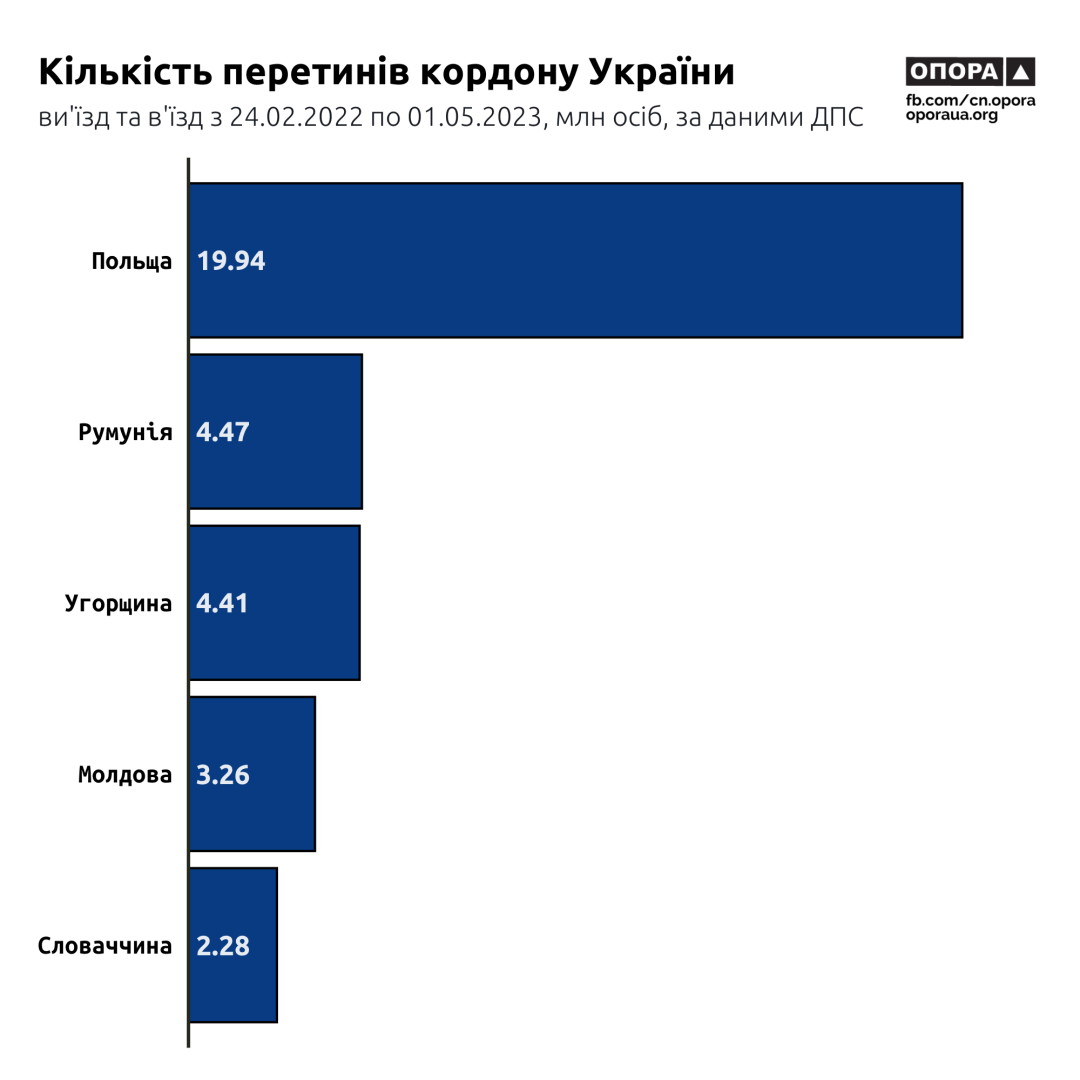
Table. Number of border crossings from 02/24/2022 to 05/01/2023 according to the State Border Guard Service
It is worth noting that Ukrainian statistics, for objective reasons, do not take into account people who found themselves under temporary occupation and were forcibly moved to the territory of Russia or Belarus, and from there they traveled to other countries to seek asylum - the State Border Guard Service could not record their departure. However, according to official statistics, there is still a small number of border crossings with Russia and Belarus. By the way, these are the only countries with more entries into Ukraine than exits.
Also, the SBGS data does not take into account illegal border crossings, in particular by men aged 18-60. Thus, as of early March 2023, SBGS spokesman Andriy Demchenko said that since February 24, 2022, border guards have detained more than 11,000 violators who tried to leave outside checkpoints. Another 4,000 people attempted to leave Ukraine using forged documents and other illegal means.
Mobile operators
Data from mobile operators can be a source of information about the actual number of residents of Ukraine. This information was already used by the Ukrainian government to calculate the population in 2019. Therefore, the Civil Network OPORA sent a request to the State Commission for Communications and received data on the number of cards of Kyivstar, Vodafone and Lifecell mobile operators.
Thus, as of June 6, 2023, the number of active cards of the mobile network amounted to just over 48.3 million. Kyivstar accounted for 24.3 million cards, Vodafone - 15.4 million, and Lifecell - 8.6 million. The highest number of active cards was recorded in Kyiv - 5.5 million, in Dnipropetrovs'k region - 4.6 million, and in Lviv region - 3.65 million.
The March report of the National Commission for the Regulation of Communications (NCRC) indicates that there are 143 cards per 100 residents of Ukraine on average. Given this, we can assume that there are no more than 33.8 million people in the unoccupied territory of Ukraine.
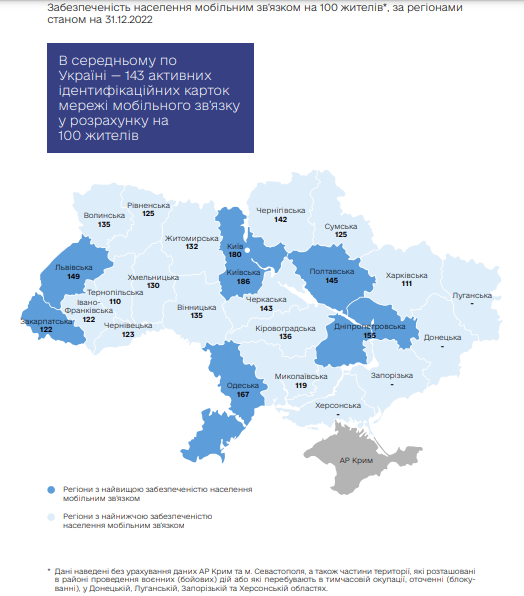
If we take into account the average indicators of mobile coverage by region from the same report, the population of the occupied and non-occupied parts of Donetsk, Luhansk, Kherson, and Zaporizhzhia regions, as well as the occupied Crimea, will be 31.5 million people. But again, this is an estimated and rather conditional figure.
In this case, the most populated regions will be Kyiv - 3 million inhabitants, Dnipropetrovs'k region - 2.97 million, Kharkiv region - 2.66 million, and Lviv region - 2.45 million. The least populated regions will be Kirovohrad - 1.15 million, Ternopil - 1.09 million, and Bukovyna - 1.06 million.
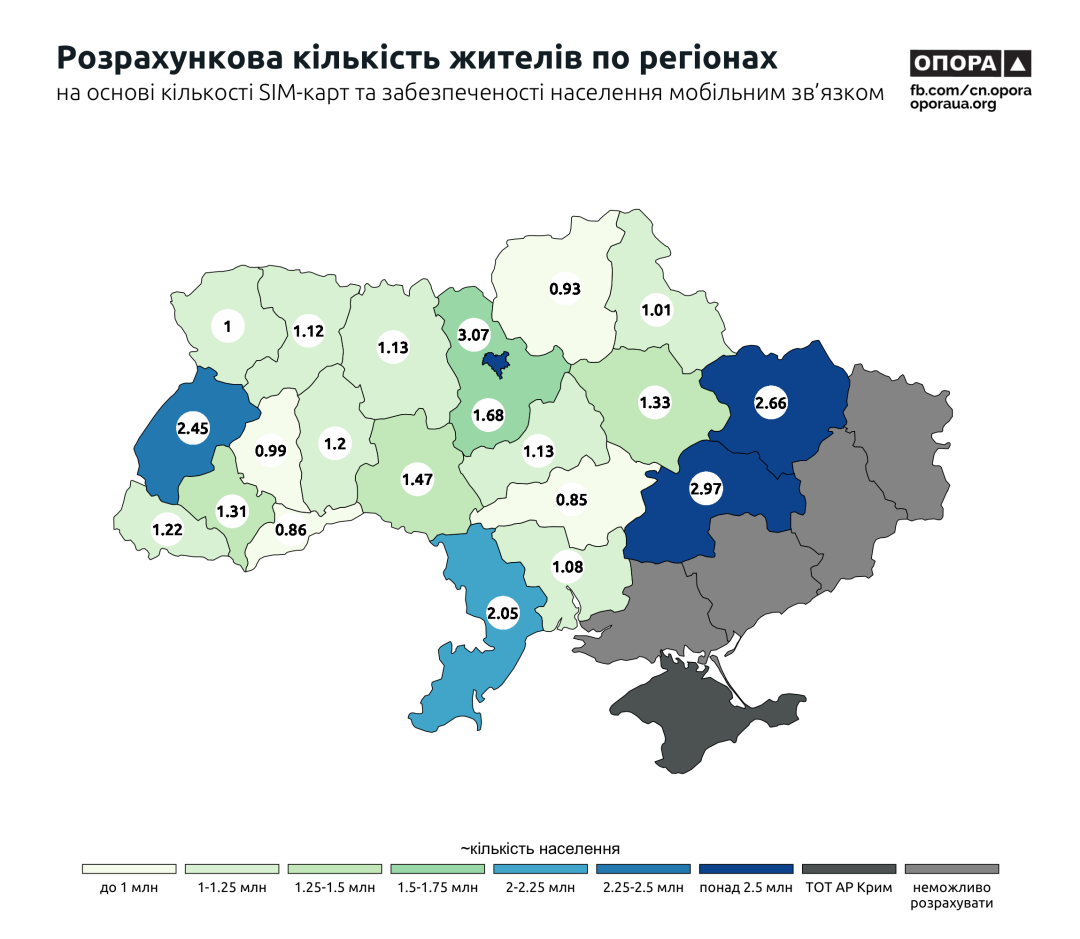
The NCRC also reports a significant reduction in the number of cards over the past year and a half. Thus, if we compare December 31, 2021, with the same day in 2022, the reduction reaches 12% or 6.6 million cards. It should be noted that in the first five months of 2023, the number of cards also decreased by about 1 million.
Accordingly, taking into account the data on mobile coverage per 100 inhabitants, we can assume that the number of Ukrainian residents as of June 6, 2023, compared to December 31, 2021, decreased by more than 7 million people.
At the same time, the estimate of the total population in December 2021 according to the NCRC will be virtually identical to the State Statistics Service.
Additionally, we emphasize that in its report, the NCRC notes that the reduction in the number of active SIM cards is due to "the full-scale invasion of the Russian Federation, the inaccessibility of mobile networks in the temporarily occupied territories of Ukraine and the reduction in the use of national mobile operators' services as a result of migration of the population to seek refuge outside the country."
United Nations High Commissioner for Refugees (UNHCR)
The UNHCR is the leading organization dedicated to protecting the rights and well-being of refugees, asylum seekers and stateless persons around the world. The way the organization implements its mandate is by collecting, analyzing and disseminating data on the situation of the respective population groups. In particular, it regularly publishes information on the number of Ukrainians abroad.
Thus, as of June 26, 2023, according to UNHCR estimates, there are 5,977,000 Ukrainian IDPs in Europe. There are almost 362,000 more outside Europe. This information is based on information published or received from the authorities of more than 40 countries on the number of Ukrainian IDPs in their countries, including Russia and Belarus.
However, Ukraine currently does not know how many of its citizens are on the territory of the aggressor countries, let alone how many of them went there voluntarily and how many were forcibly deported by the occupying forces. Therefore, the figure of 1.3 million Ukrainian citizens in Russia and Belarus is questionable. That is why it can be assumed that as of June 26, there were just over 5 million Ukrainian IDPs abroad, of which almost 4.7 million were in Europe. According to the UNHCR, the largest number of Ukrainians are in Germany (1.07 million). Poland is in second place (994 thousand), and the Czech Republic is in third place (345,000).
The number of IDPs from Ukraine in European countries according to the UNHCR:
It is worth noting that UNHCR does not publish information in the open data format, which makes it difficult to process. In addition, the Office uses data provided by national governments (hence the information from Russia and Belarus). This may also explain why the methodology and method of publishing information changes periodically and is more relevant to displaced persons in European countries.
The Civil Network OPORA tried to find out the dynamics of changes in the number of Ukrainians abroad. In our calculations, we did not take into account the data provided by Russia and Belarus because of the lack of trust in them, as the UNHCR portal often shows the number of Ukrainians in the status of displaced persons in these two countries as if they were equal to the number of Ukrainians who crossed the border with them.
Based on the UNHCR data, it can be established that over the past year, the number of Ukrainians in Europe has increased by more than 725,000 people. It reached its peak in March-May 2023 (almost 5.3 million people) and is now gradually decreasing - in particular, due to Poland, where the number of IDPs from Ukraine has decreased by more than 550,000 people over the past six months.
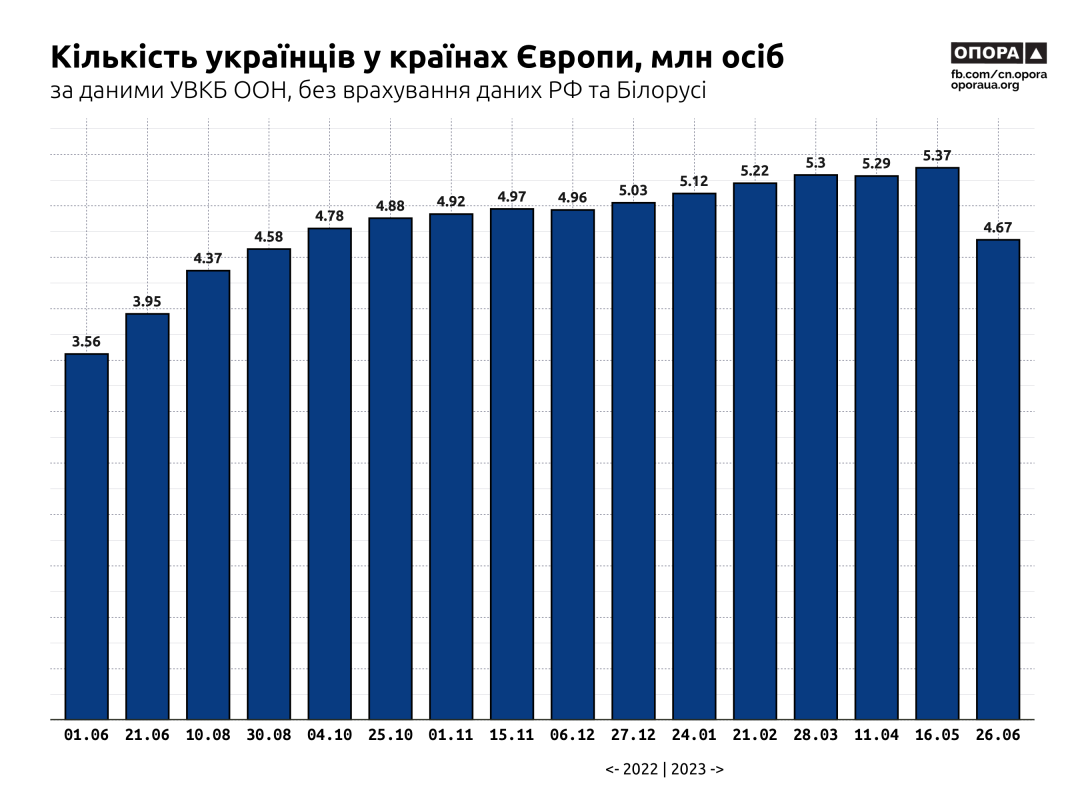
Dynamics of the number of Ukrainians in Europe according to UNHCR
Another important source of data is information on border crossings published on the UNHCR website. Not taking into account the Russian and Belarusian data, we note that from February 24, 2022, to June 26, 2023, 20.64 million departures from Ukraine and 14.34 million entries were recorded.
Accordingly, it can be assumed that since February 24 last year, about 6.29 million people have left Ukraine and never returned. It should also be noted that this figure has continued to grow since mid-October 2022.
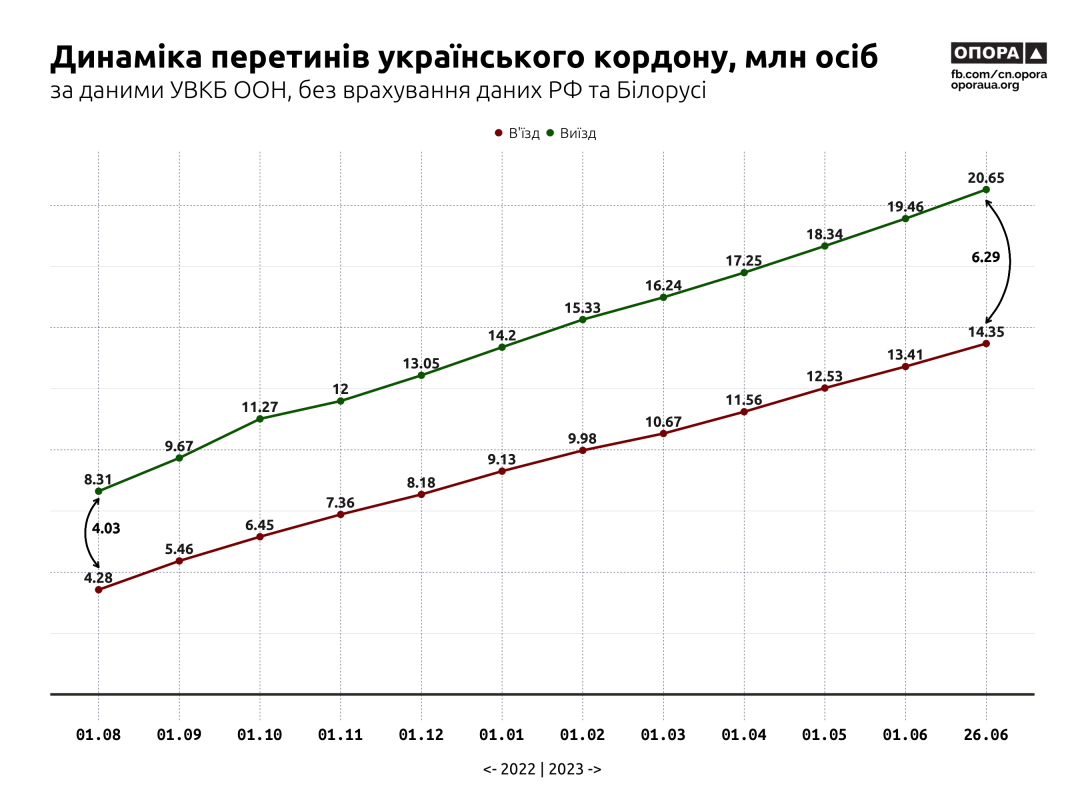
Table. Dynamics of the number of crossings of the Ukrainian border according to UNHCR
It is also worth noting that our estimate based on UNHCR data does not take into account Ukrainians forced to leave through the territory of Russia and seek asylum in other countries. It is also impossible to estimate the number of Ukrainians forcibly deported to the territory of the Russian Federation.
Although, according to the governments of European countries, the number of IDPs from Ukraine in their countries is decreasing (in particular, due to Poland), the dynamics of border crossings shows that Ukrainian citizens continue to leave and do not return. Some Ukrainians migrate to non-European countries, such as the United States, Canada, and Israel. It is also possible that it is becoming more difficult to count Ukrainian migrants abroad, in particular due to the abolition of benefits in host countries.
INTERNALLY DISPLACED PERSONS (IDPS)
According to Ukrainian law, internally displaced persons are people who have been forced to leave or abandon their place of residence as a result of or in order to avoid the negative consequences of armed conflict, temporary occupation, widespread violence, human rights violations and natural or man-made emergencies.
In response to a request from the Civil Network OPORA, the Ministry of Social Policy reported that as of June 9, 2023, 4,871,807 people were registered as internally displaced in Ukraine, of whom 60% were women and 40% were men. It should be emphasized that the full-scale invasion forced 700 people aged 100 and older to leave their homes.
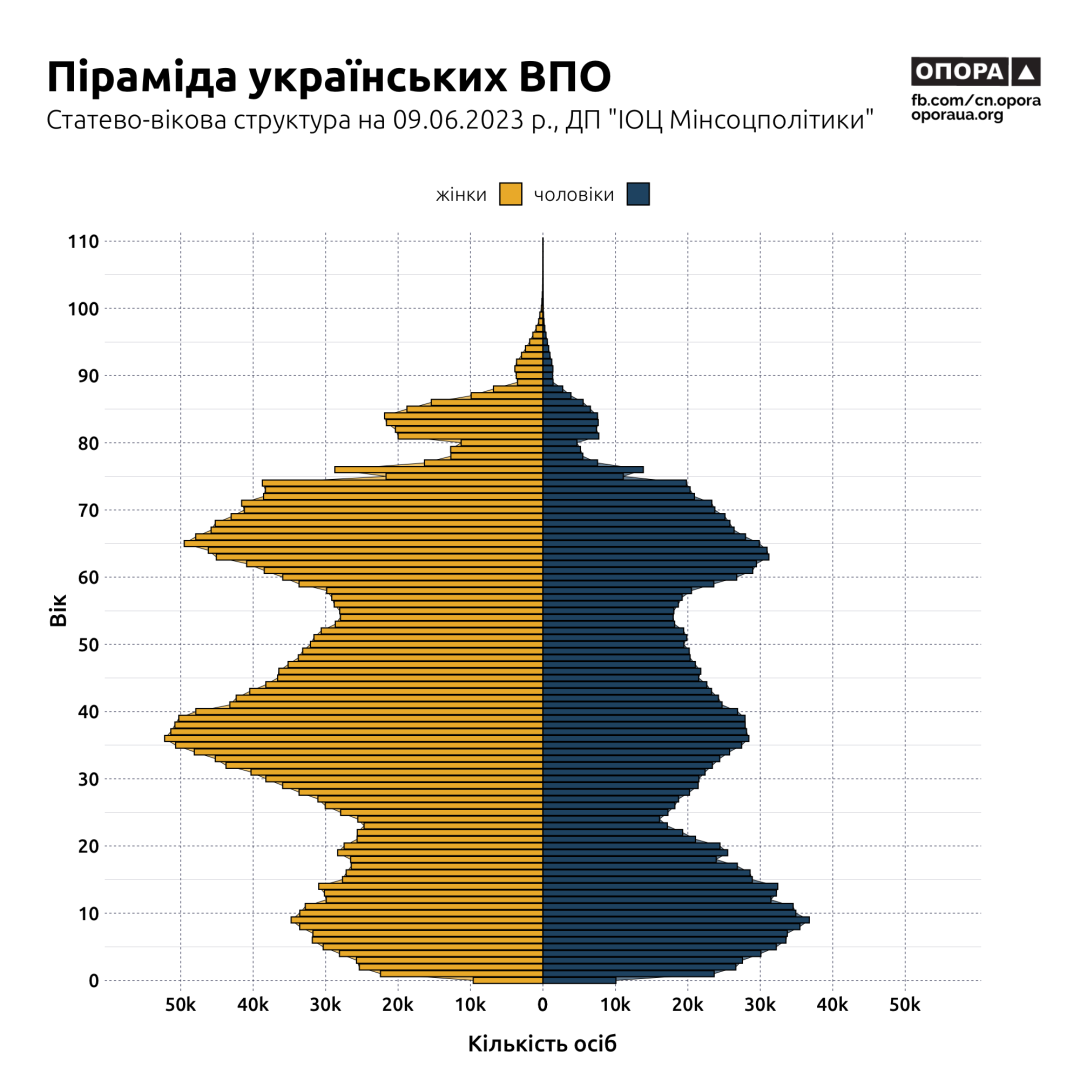
Table. Gender and age structure of Ukrainian IDPs according to the Ministry of Social Policy
Comparing the dynamics, the number of IDPs has remained virtually unchanged over the past six months, decreasing by only 21,000 people.
It is worth noting that the Ministry of Social Policy only operates with data on those who have received a certificate of IDP registration. That is, people who did not register this status for various reasons are not included in the table above.
KEY FINDINGS AND TRENDS
- According to various estimates, before the full-scale invasion, between 37.3 and 43.8 million people lived on the territory of Ukraine. As of February 1, 2022, the State Statistics Service estimated the population (excluding the Autonomous Republic of Crimea) at 41.1 million people. A calculation based on data from mobile operators showed roughly the same figure. However, in December 2019, the government estimated the number of residents of Ukraine (excluding those who permanently live in the occupied territories) at 37.3 million. That is why the likely population of Ukraine before a full-scale war may be less than 40 million people.
- Even according to the most conservative estimates, Ukraine's population decreased by more than 8 million people between 1991 and February 24, 2022.
- According to the State Statistics Service, the annual decline in Ukraine's population even before the full-scale Russian invasion was more than 420,000 people.
- According to the Ukrainian Ministry of Foreign Affairs, as of June 21, 2023, 8,177,000 Ukrainian citizens are abroad, about 20% of the population of Ukraine as of February 24, 2022. Almost half of Ukrainians are in just three countries: Poland - 22%, Germany - 15%, and the United States - 11%. Only 6% of Ukrainians abroad are registered with the consulate.
- As of June 26, 2023, the UNHCR reported 5 million Ukrainian IDPs (excluding data provided by Russia and Belarus), but this figure is still enormous. Almost 2 million Ukrainian IDPs (40%) are in two European countries - Germany and Poland. It should be noted that the Population Division of the UN Department of Economic and Social Affairs estimates the population of Ukraine in 2023 at 36.74 million people. This figure may well be realistic, albeit somewhat optimistic.
- Information published by the UNHCR suggests that since February 24 last year, about 6.29 million people have left Ukraine and never returned. Since mid-October 2022, this figure has continued to grow. Thus, if we do not take into account Russian and Belarusian data (due to doubts about their reliability), according to UNHCR estimates, from February 24, 2022, to June 26, 2023, 20.64 million departures from Ukraine and 14.34 million entries were recorded.
- According to the Ukrainian State Tax Service, the difference between departures and entries of Ukrainians outside the country from February 24, 2022, to May 1, 2023, is negative and amounts to 2,686,000 people. In April 2023, the negative migration balance increased by 31,000 crossings. This increase is insignificant compared to the truly massive outflows in December 2022-March 2023, when the negative balance increased by more than 1.8 million people. This may be due to the blackout and massive Russian shelling.
- Another source of information on the current number of residents of Ukraine may be data from mobile operators. The Ukrainian government already used this information to estimate the existing population in 2019. According to the NCCR, as of June 2023, there were 48.3 million active cards in the Ukrainian mobile network. Since the report of the National Commission for the Regulation of Communications indicates that there are 143 cards per 100 residents of Ukraine on average, we can assume that there are no more than 33.8 million residents in the country. Using the same calculation method, we can assume that the number of residents of Ukraine as of June 6, 2023, compared to December 31, 2021, has decreased by more than 7 million people.
- Given the ban on traveling abroad, which applies to the vast majority of Ukrainian men aged 18-60, and taking into account the results of a UN survey where more than 85% of respondents are women, we can assume that the vast majority of Ukrainians abroad are women and children under 18. Their integration into the societies of the countries of temporary residence may subsequently lead to a significant outflow of the male population of Ukraine, for example, for "family reunification." At present, it is not known for certain how many men would also wish to emigrate if they had the opportunity.
- It is worth noting that according to a UN survey (December 2022 - January 2023), 65% of respondents plan to return to Ukraine "one day," but only 12% planned to do so within the next 3 months. Therefore, it is likely that the return of Ukrainians will require significant efforts by Ukraine and partner states to create favorable security, humanitarian, and economic conditions.
- In addition to people leaving the country, Ukraine is facing massive internal migration. According to the Ministry of Social Policy, just under 4.9 million people (60% women, 40% men) have the status of internally displaced. Comparing the dynamics, the number of IDPs has remained virtually unchanged over the past six months, decreasing by only 21,000 people. It is also worth noting that the full-scale Russian invasion forced 700 people aged 100 and older to leave their homes.
This publication was prepared within the framework of the project "Civil Society for Ukraine's Post-War Recovery and EU Readiness", implemented with the financial support of the European Union. Its contents are the sole responsibility of the Civil Network OPORA and do not necessarily reflect the views of the European Union.




